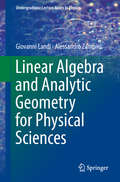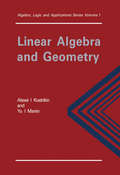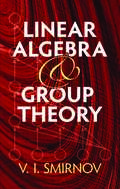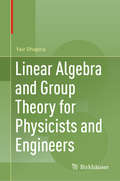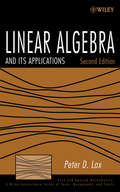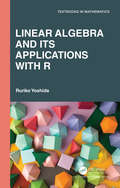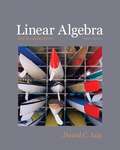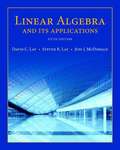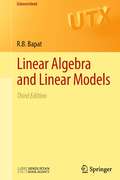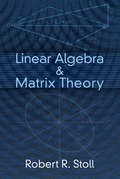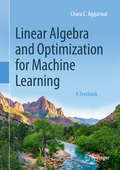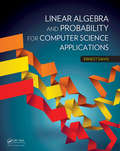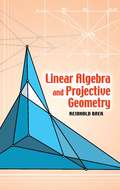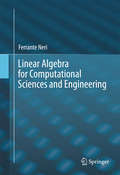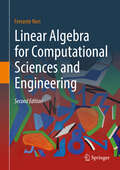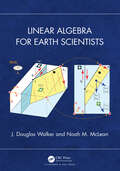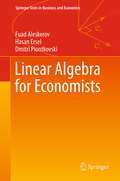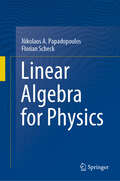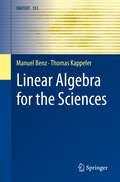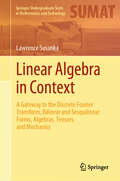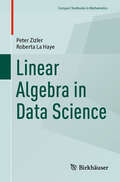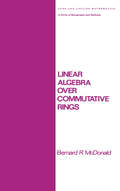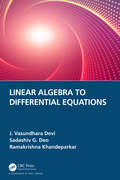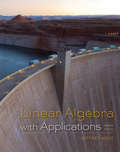- Table View
- List View
Linear Algebra and Analytic Geometry for Physical Sciences (Undergraduate Lecture Notes in Physics)
by Giovanni Landi Alessandro ZampiniA self-contained introduction to finite dimensional vector spaces, matrices, systems of linear equations, spectral analysis on euclidean and hermitian spaces, affine euclidean geometry, quadratic forms and conic sections. The mathematical formalism is motivated and introduced by problems from physics, notably mechanics (including celestial) and electro-magnetism, with more than two hundreds examples and solved exercises.Topics include: The group of orthogonal transformations on euclidean spaces, in particular rotations, with Euler angles and angular velocity. The rigid body with its inertia matrix. The unitary group. Lie algebras and exponential map. The Dirac’s bra-ket formalism. Spectral theory for self-adjoint endomorphisms on euclidean and hermitian spaces. The Minkowski spacetime from special relativity and the Maxwell equations. Conic sections with the use of eccentricity and Keplerian motions. An appendix collects basic algebraic notions like group, ring and field; and complex numbers and integers modulo a prime number.The book will be useful to students taking a physics or engineer degree for a basic education as well as for students who wish to be competent in the subject and who may want to pursue a post-graduate qualification.
Linear Algebra and Geometry (Algebra, Logic and Applications)
by Alexandra I. Kostrikin P. K. Suetin Yu I ManinThis advanced textbook on linear algebra and geometry covers a wide range of classical and modern topics. Differing from existing textbooks in approach, the work illustrates the many-sided applications and connections of linear algebra with functional analysis, quantum mechanics and algebraic and differential geometry. The subjects covered in some
Linear Algebra and Group Theory
by Richard A. Silverman V. I. SmirnovDerived from an encyclopedic six-volume survey, this accessible text by a prominent Soviet mathematician offers a concrete approach, with an emphasis on applications. Containing material not otherwise available to English-language readers, the three-part treatment covers determinants and systems of equations, matrix theory, and group theory. Problem sets, with hints and answers, conclude each chapter. 1961 edition.
Linear Algebra and Group Theory for Physicists and Engineers
by Yair ShapiraThis textbook demonstrates the strong interconnections between linear algebra and group theory by presenting them simultaneously, a pedagogical strategy ideal for an interdisciplinary audience. Being approached together at the same time, these two topics complete one another, allowing students to attain a deeper understanding of both subjects. The opening chapters introduce linear algebra with applications to mechanics and statistics, followed by group theory with applications to projective geometry. Then, high-order finite elements are presented to design a regular mesh and assemble the stiffness and mass matrices in advanced applications in quantum chemistry and general relativity.This text is ideal for undergraduates majoring in engineering, physics, chemistry, computer science, or applied mathematics. It is mostly self-contained—readers should only be familiar with elementary calculus. There are numerous exercises, with hints or full solutions provided. A series of roadmaps are also provided to help instructors choose the optimal teaching approach for their discipline.
Linear Algebra and Its Applications
by Peter D. LaxLinear Algebra and Its Applications, Second Edition presents linear algebra as the theory and practice of linear spaces and linear maps with a unique focus on the analytical aspects as well as the numerous applications of the subject. In addition to thorough coverage of linear equations, matrices, vector spaces, game theory, and numerical analysis, the Second Edition features student-friendly additions that enhance the book's accessibility, including expanded topical coverage in the early chapters, additional exercises, and solutions to selected problems.Beginning chapters are devoted to the abstract structure of finite dimensional vector spaces, and subsequent chapters address convexity and the duality theorem as well as describe the basics of normed linear spaces and linear maps between normed spaces.Further updates and revisions have been included to reflect the most up-to-date coverage of the topic, including:The QR algorithm for finding the eigenvalues of a self-adjoint matrix. The Householder algorithm for turning self-adjoint matrices into tridiagonal form. The compactness of the unit ball as a criterion of finite dimensionality of a normed linear space. Additionally, eight new appendices have been added and cover topics such as: the Fast Fourier Transform; the spectral radius theorem; the Lorentz group; the compactness criterion for finite dimensionality; the characterization of commentators; proof of Liapunov's stability criterion; the construction of the Jordan Canonical form of matrices; and Carl Pearcy's elegant proof of Halmos' conjecture about the numerical range of matrices.Clear, concise, and superbly organized, Linear Algebra and Its Applications, Second Edition serves as an excellent text for advanced undergraduate- and graduate-level courses in linear algebra. Its comprehensive treatment of the subject also makes it an ideal reference or self-study for industry professionals.
Linear Algebra and Its Applications with R (Textbooks in Mathematics)
by Ruriko YoshidaThe book developed from the need to teach a linear algebra course to students focused on data science and bioinformatics programs. These students tend not to realize the importance of linear algebra in applied sciences since traditional linear algebra courses tend to cover mathematical contexts but not the computational aspect of linear algebra or its applications to data science and bioinformatics. The author presents the topics in a traditional course yet offers lectures as well as lab exercises on simulated and empirical data sets. This textbook provides students a theoretical basis which can then be applied to the practical R and Python problems, providing the tools needed for real-world applications. Each section starts with working examples to demonstrate how tools from linear algebra can help solve problems in applied science. These exercises start from easy computations, such as computing determinants of matrices, to practical applications on simulated and empirical data sets with R so that students learn how to get started with R along with computational examples in each section and then they learn how to apply what they learn to problems in applied sciences. This book is designed from first principles to demonstrate the importance of linear algebra through working computational examples with R and python including tutorials on how to install R in the Appendix. If a student has never seen R, they can get started without any additional help. Since Python is one of the most popular languages in data science, optimization, and computer science, code supplements are available for students who feel more comfortable with Python. R is used primarily for computational examples to develop student’s practical computational skills. Table of Contents PrefaceList of FiguresList of Tables1. Systems of Linear Equations and Matrices2. Matrix Arithmetic3. Deteminants4. Vector Spaces5. Inner Product Space6. Eigen values and Eigen vectors7. Linear Regression8. Linear ProgrammingNetwork AnalysisAppendicesA) Introduction to RStudio via Amazon Web Service (AWS) B) Introduction to R Bibliography Index BiographyDr. Ruriko Yoshida is an Associate Professor of Operations Research at the Naval Postgraduate School. She received her Ph.D. in Mathematics from the University of California, Davis. Her research topics cover a wide variety of areas: applications of algebraic combinatorics to statistical problems such as statistical learning on non-Euclidean spaces, sensor networks, phylogenetics, and phylogenomics. She teaches courses in statistics, stochastic models, probability, and data science.
Linear Algebra and Its Applications, 4th Edition
by David C. LayThis Fourth Edition provides a modern elementary introduction to linear algebra and a broad selection of interesting applications.
Linear Algebra and Its Applications, Fifth Edition
by David C. Lay Steven R. Lay Judi J. McdonaldWith traditional linear algebra texts, the course is relatively easy for students during the early stages as material is presented in a familiar, concrete setting. However, when abstract concepts are introduced, students often hit a wall. Instructors seem to agree that certain concepts (such as linear independence, spanning, subspace, vector space, and linear transformations) are not easily understood and require time to assimilate. These concepts are fundamental to the study of linear algebra, so students' understanding of them is vital to mastering the subject. This text makes these concepts more accessible by introducing them early in a familiar, concrete Rn setting, developing them gradually, and returning to them throughout the text so that when they are discussed in the abstract, students are readily able to understand.
Linear Algebra and Linear Models
by Ravindra B. BapatLinear Algebra and Linear Models comprises a concise and rigorous introduction to linear algebra required for statistics followed by the basic aspects of the theory of linear estimation and hypothesis testing. The emphasis is on the approach using generalized inverses. Topics such as the multivariate normal distribution and distribution of quadratic forms are included. For this third edition, the material has been reorganised to develop the linear algebra in the first six chapters, to serve as a first course on linear algebra that is especially suitable for students of statistics or for those looking for a matrix theoretic approach to the subject. Other key features include: coverage of topics such as rank additivity, inequalities for eigenvalues and singular values; a new chapter on linear mixed models; over seventy additional problems on rank: the matrix rank is an important and rich topic with connections to many aspects of linear algebra such as generalized inverses, idempotent matrices and partitioned matrices. This text is aimed primarily at advanced undergraduate and first-year graduate students taking courses in linear algebra, linear models, multivariate analysis and design of experiments. A wealth of exercises, complete with hints and solutions, help to consolidate understanding. Researchers in mathematics and statistics will also find the book a useful source of results and problems.
Linear Algebra and Matrix Theory (Dover Books on Mathematics)
by Robert R. StollOne of the best available works on matrix theory in the context of modern algebra, this text bridges the gap between ordinary undergraduate studies and completely abstract mathematics. The first five chapters treat topics important to economics, psychology, statistics, physics, and mathematics. Final chapters apply chiefly to students of engineering, physics, and advanced mathematics. 1952 edition.
Linear Algebra and Optimization for Machine Learning: A Textbook
by Charu C. AggarwalThis textbook introduces linear algebra and optimization in the context of machine learning. Examples and exercises are provided throughout this text book together with access to a solution’s manual. This textbook targets graduate level students and professors in computer science, mathematics and data science. Advanced undergraduate students can also use this textbook. The chapters for this textbook are organized as follows:1. Linear algebra and its applications: The chapters focus on the basics of linear algebra together with their common applications to singular value decomposition, matrix factorization, similarity matrices (kernel methods), and graph analysis. Numerous machine learning applications have been used as examples, such as spectral clustering, kernel-based classification, and outlier detection. The tight integration of linear algebra methods with examples from machine learning differentiates this book from generic volumes on linear algebra. The focus is clearly on the most relevant aspects of linear algebra for machine learning and to teach readers how to apply these concepts.2. Optimization and its applications: Much of machine learning is posed as an optimization problem in which we try to maximize the accuracy of regression and classification models. The “parent problem” of optimization-centric machine learning is least-squares regression. Interestingly, this problem arises in both linear algebra and optimization, and is one of the key connecting problems of the two fields. Least-squares regression is also the starting point for support vector machines, logistic regression, and recommender systems. Furthermore, the methods for dimensionality reduction and matrix factorization also require the development of optimization methods. A general view of optimization in computational graphs is discussed together with its applications to back propagation in neural networks. A frequent challenge faced by beginners in machine learning is the extensive background required in linear algebra and optimization. One problem is that the existing linear algebra and optimization courses are not specific to machine learning; therefore, one would typically have to complete more course material than is necessary to pick up machine learning. Furthermore, certain types of ideas and tricks from optimization and linear algebra recur more frequently in machine learning than other application-centric settings. Therefore, there is significant value in developing a view of linear algebra and optimization that is better suited to the specific perspective of machine learning.
Linear Algebra and Probability for Computer Science Applications
by Ernest DavisBased on the author's course at NYU, Linear Algebra and Probability for Computer Science Applications gives an introduction to two mathematical fields that are fundamental in many areas of computer science. The course and the text are addressed to students with a very weak mathematical background. Most of the chapters discuss relevant MATLAB functi
Linear Algebra and Projective Geometry
by Reinhold BaerGeared toward upper-level undergraduates and graduate students, this text establishes that projective geometry and linear algebra are essentially identical. The supporting evidence consists of theorems offering an algebraic demonstration of certain geometric concepts. These focus on the representation of projective geometries by linear manifolds, of projectivities by semilinear transformations, of collineations by linear transformations, and of dualities by semilinear forms. These theorems lead to a reconstruction of the geometry that constituted the discussion's starting point, within algebraic structures such as the endomorphism ring of the underlying manifold or the full linear group.Restricted to topics of an algebraic nature, the text shows how far purely algebraic methods may extend. It assumes only a familiarity with the basic concepts and terms of algebra. The methods of transfinite set theory frequently recur, and for readers unfamiliar with this theory, the concepts and principles appear in a special appendix.
Linear Algebra for Computational Sciences and Engineering
by Ferrante NeriThis book presents the main concepts of linear algebra from the viewpoint of applied scientists such as computer scientists and engineers, without compromising on mathematical rigor. Based on the idea that computational scientists and engineers need, in both research and professional life, an understanding of theoretical concepts of mathematics in order to be able to propose research advances and innovative solutions, every concept is thoroughly introduced and is accompanied by its informal interpretation. Furthermore, most of the theorems included are first rigorously proved and then shown in practice by a numerical example. When appropriate, topics are presented also by means of pseudocodes, thus highlighting the computer implementation of algebraic theory. It is structured to be accessible to everybody, from students of pure mathematics who are approaching algebra for the first time to researchers and graduate students in applied sciences who need a theoretical manual of algebra to successfully perform their research. Most importantly, this book is designed to be ideal for both theoretical and practical minds and to offer to both alternative and complementary perspectives to study and understand linear algebra.
Linear Algebra for Computational Sciences and Engineering
by Ferrante NeriThis book presents the main concepts of linear algebra from the viewpoint of applied scientists such as computer scientists and engineers, without compromising on mathematical rigor. Based on the idea that computational scientists and engineers need, in both research and professional life, an understanding of theoretical concepts of mathematics in order to be able to propose research advances and innovative solutions, every concept is thoroughly introduced and is accompanied by its informal interpretation. Furthermore, most of the theorems included are first rigorously proved and then shown in practice by a numerical example. When appropriate, topics are presented also by means of pseudocodes, thus highlighting the computer implementation of algebraic theory.It is structured to be accessible to everybody, from students of pure mathematics who are approaching algebra for the first time to researchers and graduate students in applied sciences who need a theoretical manual of algebra to successfully perform their research. Most importantly, this book is designed to be ideal for both theoretical and practical minds and to offer to both alternative and complementary perspectives to study and understand linear algebra.
Linear Algebra for Earth Scientists
by Noah M. McLean J. Douglas WalkerLinear Algebra for Earth Scientists is written for undergraduate and graduate students in Earth and Environmental sciences. It is intended to give students enough background in linear algebra to work with systems of equations and data in geology, hydrology, geophysics, or whatever part of the Earth Sciences they engage with.The book does not presuppose any extensive prior knowledge of linear algebra. Instead, the book builds students up from a low base to a working understanding of the sub t that they can apply to their work, using many familiar examples in the geosciences.Features Suitable for students of Earth and Environmental Sciences Minimal prerequisites — written in a way that is accessible and engaging for those without a mathematical background All material presented with examples and applications to the Earth Sciences
Linear Algebra for Economists
by Hasan Ersel Fuad Aleskerov Dmitri PiontkovskiThis textbook introduces students of economics to the fundamental notions and instruments in linear algebra. Linearity is used as a first approximation to many problems that are studied in different branches of science, including economics and other social sciences. Linear algebra is also the most suitable to teach students what proofs are and how to prove a statement. The proofs that are given in the text are relatively easy to understand and also endow the student with different ways of thinking in making proofs. Theorems for which no proofs are given in the book are illustrated via figures and examples. All notions are illustrated appealing to geometric intuition. The book provides a variety of economic examples using linear algebraic tools. It mainly addresses students in economics who need to build up skills in understanding mathematical reasoning. Students in mathematics and informatics may also be interested in learning about the use of mathematics in economics.
Linear Algebra for Physics
by Florian Scheck Nikolaos A. PapadopoulosThis textbook provides a full treatment of Linear Algebra devoted to undergraduate and graduate physics students. Although the mathematical level is similar to the corresponding mathematical textbooks in regard to definitions, propositions and proofs, it adopts a language and approach more attuned to the reader’s familiarity with physics lectures and physics textbooks. A distinctive feature is the emphasis placed on the significance of bases within a vector space. As a result, students gain a deeper understanding of how vector indices, despite their abundance, serve not as enemies but as friends since they give additional information about the mathematical objects being used, and facilitate access to tensor formalism. The book offers numerous worked examples and exercises with solution hints to deepen this knowledge.
Linear Algebra for the Sciences (UNITEXT #151)
by Thomas Kappeler Manuel BenzThis book is based on a course for first-semester science students, held by the second author at the University of Zurich several times. Its goal is threefold: to have students learn a minimal working knowledge of linear algebra, acquire some computational skills, and familiarize them with mathematical language to make mathematical literature more accessible. Therefore, we give precise definitions, introduce helpful notations, and state any results carefully worded. We provide no proofs of these results but typically illustrate them with numerous examples. Additionally, for better understanding, we often give supporting arguments for why they are valid.
Linear Algebra in Context: A Gateway to the Discrete Fourier Transform, Bilinear and Sesquilinear Forms, Algebras, Tensors and Mechanics (Springer Undergraduate Texts in Mathematics and Technology)
by Lawrence SusankaThis text combines a compact linear algebra course with a serious dip into various physical applications. It may be used as a primary text for a course in linear algebra or as a supplementary text for courses in applied math, scientific computation, mathematical physics, or engineering. The text is divided into two parts. Part 1 comprises a fairly standard presentation of linear algebra. Chapters 1–3 contain the core mathematical concepts typical for an introductory course while Chapter 4 contains numerous "short" applications. Chapter 5 is a repository of standard facts about matrix factorization and quadratic forms together with the "connective tissue" of topics needed for a coherent discussion, including the singular value decomposition, the Jordan normal form, Sylvester's law of inertia and the Witt theorems. Part I contains around 300 exercises, found throughout the text, and are an integral part of the presentation. Part 2 features deeper applications. Each of these "large" applications require no more than linear algebra to discuss, though the style and arrangement of results would be challenging to a beginning student and more appropriate for a second or later course. Chapter 6 provides an introduction to the discrete Fourier transform, including the fast Fourier algorithm. Chapter 7 is a thorough introduction to isometries and some of the classical groups, and how these groups have come to be important in physics. Chapter 8 is a fairly detailed look at real algebras and completes a presentation of the classical Lie groups and algebras. Chapter 9 is a careful discussion of tensors on a finite-dimensional vector space, finishing with the Hodge Star operator and the Grassmann algebra. Finally, Chapter 10 gives an introduction to classical mechanics including Noether's first theorem and emphasizes how the classical Lie groups, discussed in earlier chapters, become important in this setting. The Chapters of Part 2 are intended to give a sense of the ubiquity, of the indispensable utility, of linear algebra in modern science and mathematics and some feel for way it is actually used in disparate subject areas. Twelve appendices are included. The last seven refer to MATLAB® code which, though not required and rarely mentioned in the text, can be used to augment understanding. For example, fifty-five MATLAB functions implement every tensor operation from Chapter 9. A zipped file of all code is available for download from the author's website.
Linear Algebra in Data Science (Compact Textbooks in Mathematics)
by Peter Zizler Roberta La HayeThis textbook explores applications of linear algebra in data science at an introductory level, showing readers how the two are deeply connected. The authors accomplish this by offering exercises that escalate in complexity, many of which incorporate MATLAB. Practice projects appear as well for students to better understand the real-world applications of the material covered in a standard linear algebra course. Some topics covered include singular value decomposition, convolution, frequency filtering, and neural networks. Linear Algebra in Data Science is suitable as a supplement to a standard linear algebra course.
Linear Algebra over Commutative Rings
by Bernard R. McDonaldThis monograph arose from lectures at the University of Oklahoma on topics related to linear algebra over commutative rings. It provides an introduction of matrix theory over commutative rings. The monograph discusses the structure theory of a projective module.
Linear Algebra to Differential Equations
by J. Vasundhara Devi Sadashiv G. Deo Ramakrishna KhandeparkarLinear Algebra to Differential Equations concentrates on the essential topics necessary for all engineering students in general and computer science branch students, in particular. Specifically, the topics dealt will help the reader in applying linear algebra as a tool. The advent of high-speed computers has paved the way for studying large systems of linear equations as well as large systems of linear differential equations. Along with the standard numerical methods, methods that curb the progress of error are given for solving linear systems of equations. The topics of linear algebra and differential equations are linked by Kronecker products and calculus of matrices. These topics are useful in dealing with linear systems of differential equations and matrix differential equations. Differential equations are treated in terms of vector and matrix differential systems, as they naturally arise while formulating practical problems. The essential concepts dealing with the solutions and their stability are briefly presented to motivate the reader towards further investigation. This book caters to the needs of Engineering students in general and in particular, to students of Computer Science & Engineering, Artificial Intelligence, Machine Learning and Robotics. Further, the book provides a quick and complete overview of linear algebra and introduces linear differential systems, serving the basic requirements of scientists and researchers in applied fields. Features Provides complete basic knowledge of the subject Exposes the necessary topics lucidly Introduces the abstraction and at the same time is down to earth Highlights numerical methods and approaches that are more useful Essential techniques like SVD and PCA are given Applications (both classical and novel) bring out similarities in various disciplines: Illustrative examples for every concept: A brief overview of techniques that hopefully serves the present and future needs of students and scientists.
Linear Algebra with Applications
by Jeffrey HoltPreparing you for conceptual thinking in an abstract setting. Linear Algebra with Applications, Second Edition, blends computational and conceptual topics throughout to prepare you for the rigors of conceptual thinking in an abstract setting. The early treatment of conceptual topics in the context of Euclidean space gives you more time, and a familiar setting, in which to absorb them. This organization also makes it possible to treat eigenvalues and eigenvectors earlier than in most texts. Abstract vector spaces are introduced later, once you have developed a solid conceptual foundation. Concepts and topics are frequently accompanied by applications to give you context and motivation. For those who learn best by example, Linear Algebra with Applications provides a large number of representative examples, over and above those used to introduce topics. The text also includes practice problems and over 2500 exercises, exposing you to computational and conceptual topics over a range of difficulty levels.
Linear Algebra with Applications (Second Edition)
by Jeffrey HoltHolt's Linear Algebra with Applications, Second Edition, blends computational and conceptual topics throughout to prepare students for the rigors of conceptual thinking in an abstract setting. The early treatment of conceptual topics in the context of Euclidean space gives students more time, and a familiar setting, in which to absorb them. This organization also makes it possible to treat eigenvalues and eigenvectors earlier than in most texts. Abstract vector spaces are introduced later, once students have developed a solid conceptual foundation. <p><p> Concepts and topics are frequently accompanied by applications to provide context and motivation. Because many students learn by example, Linear Algebra with Applications provides a large number of representative examples, over and above those used to introduce topics. The text also has over 2500 exercises, covering computational and conceptual topics over a range of difficulty levels.
